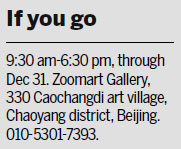

When he doesn't work in his studio, Tong Zhengang, 56, prefers hanging out and having a drink with his dozen buddies: All are Beijing-based artists like him, and most were born in the 1960s.
They have gone through the twists and turns of Chinese contemporary art since the avant-garde art movement known as '85 New Wave.
They have a group chat room on WeChat, called "ge men'r (brothers), ye men'r (men)".
|
Brotherhood, Manhood is a showcase of artworks by a group Chinese artists born in the 1960s. Provided to China Daily |
"We come from different places. We differ a lot in personality. We work with different art mediums and our views on the contemporary art diverge," Tong says.
"What we have in common is that we've never abandoned the profession of artist over the past three decades. It is our shared persistence in art that has made us a band of brothers."
To mark their unremitting tenacity and friendship, Tong planned a group exhibition, titled Brotherhood, Manhood, that's ongoing at Zoomart Gallery in Beijing's Caochangdi art village. The exhibition runs through Dec 31.
Tong and his 13 "brother" artists show works belonging to various media, which provide clues to review and understand the evolution of the Chinese art landscape since 1985.
Tong says it is, however, too vague and general to label these works as "contemporary art".
"Even though we were professionally trained to paint, to draw or to sculpt, our languages have already crossed the boundaries of techniques and art styles of the past and present."
He adds that art is only the manifestation of their sensitivity to their surroundings, and for his generation of artists, art has become a tool to challenge their patience and physical limitations.
One can't agree more with that perspective after seeing works of Mo Gen, a 50-year-old oil painter of the Zhuang ethnic group, who is from Guizhou province.
Since the late 1990s, he has explored by creating distinctive portraits of people in water. He uses only three colors - gray, blue and white - to present the tranquility and infinity of water.
The figures in his paintings, whether men, women or children, have no expression, and viewers have no clue of their identities, such as who they are and how they make a living.
Mo says these figures are reflections of viewers themselves, and the water represents social circumstances.
"There is chaos and disorder in it. People will get lost in it. They may be engulfed by a whirlpool of social changes without realizing what has happened," he explains.

He attempts to raise viewers' awareness of how they coexist with their surroundings, by detaching themselves from the mainstream or being carried along with it.
In Zhang Xiaodong's works, the 47-year-old delves into the same theme while being more specific about people's attitudes toward money.
His Big Money Purses series combines oil painting with collages of cloth pieces. They feature highly cartoonized images and vivid colors.
Zhang lived in Japan for years to complete his master's degree. He was influenced by animation aesthetics there and experiments with translating the language of animation and pop art into the context of Chinese art and social realities.
He says does not criticize money worship or materialistic values in his works, but he views it more as a revolutionary concept through which people strive for a better living - forcing them to juggle between the right and wrong.